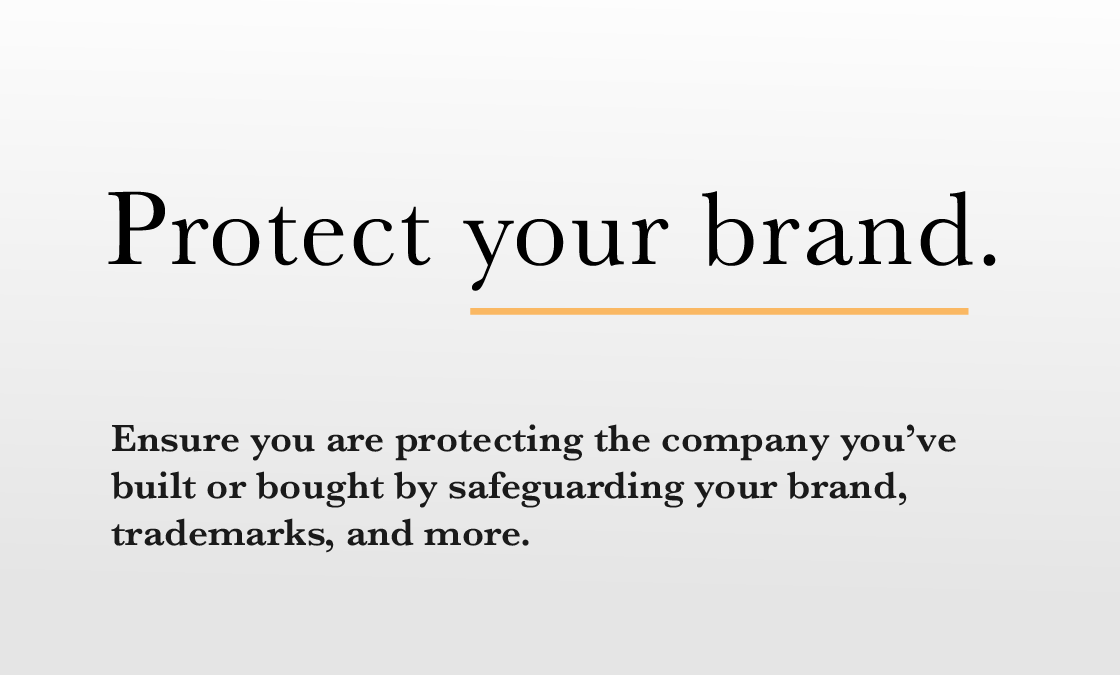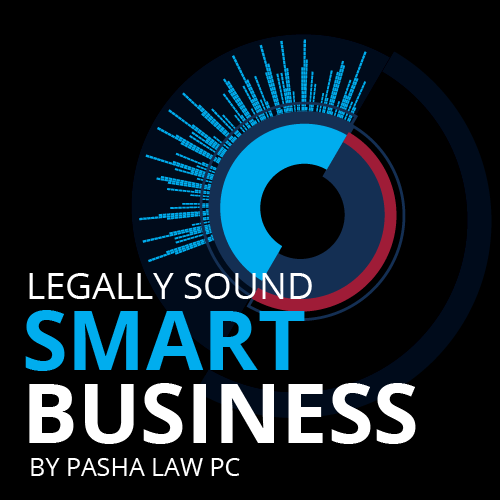Perhaps you’re never dreamed of a Google or Facebook-sized business empire – multiple products generating multiple streams of income that seem to semi-magically renew themselves. Something a bit more modest might be fine as well.
Whatever the size of your dreams, a strong brand is an essential element. As defined by the American Marketing Association, a brand is a “[n]ame, symbol, or any other feature that identifies one seller’s good or service as distinct from those of other sellers.” It is how the public views and feels about the values, products,services and personality of your brand.
It can make a great first impression, distinguish your business from the competition, establish loyalty, trust and repeat customers and inspire employees.
Establishing and defending your brand is no accident, however. Here are nine legal strategies to create a strong brand in the first place, and then protect the goodwill it creates for your enterprise.
Make it Distinctive
Make sure that your business name, logo, tag line, hashtag, website design, business process and every other important element of your business identity is distinctive and not in use by anyone else. The more distinctive it is, the easier it will be for your customers to remember and the easier it will be to protect.
You can search trademarks to ensure that they are free by searching the Trademark Electronic Search System (TESS).
Establish a Common Thread
If you offer several products or services, consider what is often referred to as the “common thread technique,” using some variation on the same distinctive name to tie them together in mutually supportive “brand family.” Perhaps the best example is the extensive Oprah empire including the Oprah Winfrey Network (OWN), O, the Oprah magazine, and Harpo productions.
Register Your Domain Name
Your domain name should be unique, short, easy to remember, easy to type, and fulfill expectations. It is probably wise to purchase .com, .net and .org versions for branding.
Make sure that the domain name is available, as you can do when purchasing through GoDaddy or any other domain registrar. Keep in mind that there are now other options instead of just the traditional .com, .net and .org.
Register your domain name and as many as possible similar domain names to prevent competitors from poaching your business.
Protect Everything Possible with Federal Law
Once you have assembled all the identifying elements of your business, protect them to the full degree possible under federal intellectual property laws. This is not the place to save on costs.
- If you’ve invented something unique and revolutionary, you will want to get a patent. A patent can be granted to an inventor “to exclude others from making, using, offering for sale, or selling the invention throughout the United States or importing the invention into the United States.” Don’t limit your thinking to machinery; business processes may be patentable, as well. Just keep in mind that patents have an expiration date.
- Federal copyright law protects original creative works, such as literature, design, computer code and music, and may also apply to advertising campaigns with an extended narrative line;
- Trademark law, which exists in federal, state and common law varieties, covers names, logos, hashtags, and the general appearance of a product or a symbol like a mascot. A word or phrase that’s commonly used or already connected with another product or service in the same industry cannot be trademarked. For example, a generic term like “search engine” can’t be trademarked, but a unique name, like Google, can be.
Don’t Ignore State and Common Law
The patent process, in particular, can be quite slow. Many entrepreneurs protect their unique inventions or processes with common law trademarks or service marks while the application is pending.
Common law trademark protection arises through use and is geographically limited. State trademark registration provides somewhat more protection and serves as evidence of ownership. Neither, though, provides the nationwide protection that federal trademark registration does.
Most states have also adopted some form of the Uniform Trade Secrets Act. These laws may be useful when a process, formula or secret recipe is not unique enough to qualify for federal patent or copyright protections.
It must, however, be a secret and valuable to the business, as is apparently the case for a certain secret family recipe for baked beans. In the event of unauthorized disclosure, an employer can generally seek damages or injunctive relief. Trade secret protection is usually enforced through nondisclosure agreements required of employees.
It is equally important that your business attorney review any contracts with independent developers, designers and other contractors to ensure that ownership of whatever intellectual property is created resides in the business and not the contractor.
Police your Brand
This may be the most important step of all. If you don’t know whether someone is damaging the value of your brand, you can’t prevent it. Set up a plan to monitor your brand and the brands of your competitors. TrackMaven and Rival IQ are two tools for tracking your brand online, but Google Alerts and Twitter searches can help, as well.
Even when the issue is not unfair competition, you should know what people, including your employees, are saying on social media sites about your business. Free tools, including Social Mention, TweetReach, and Addictomatic may help you keep up with trends and analyze how effective your marketing campaigns are. Image Raider will tell you if someone is using your images. Hootsuite is another free resource to help you manage all of your social media accounts from one location.
If your business has a significant problem with negative employee comments on social media, it may be wise to take more formal steps, perhaps by adding a statement about social media expectations in the employee handbook.
Send Cease and Desist Letters
When you discover that your protected intellectual property is being infringed upon, act immediately. A cease and desist letter on your attorney’s stationery is often all that is necessary, although you may have to sue. Do not hesitate to do so when it appears to be necessary.
Where the infringement is electronic, a takedown notice under the Digital Millennium Copyright Act can be very effective. They are short and simple to prepare and the infringer must take down the copied material pending resolution of any dispute about ownership.
Consider Protecting Your Brand Overseas
Depending on the nature of your business, it may be necessary to take the additional and somewhat expensive step of seeking international protection, particularly in China. Unlike in the United States, which gives priority protection to the first to use a particular mark, China uses a first-to-file system. It can create a race to the registration office, so it’s a good strategy to register as soon as possible.
Consider Creating Legally Separate Divisions
It is not a strategy that is unique to brand issues, but a business that is divided into separate legal entities that hold separate assets, including intellectual property, may be better able to weather unexpected infringement or a public relations disaster that damages the value of one product but not all. Even apart from the question of legal liability for damages, separate legal divisions may protect the value of another brand.
Creating and protecting a strong brand is essential to business success. However, it takes an initial investment of capital and energy and a continuing investment of vigilance. Careful planning and systems in place to monitor the value of your brand can pay off handsomely in the long run, however.






![Law in the Digital Age: Exploring the Legal Intricacies of Artificial Intelligence [e323]](https://www.pashalaw.com/wp-content/uploads/2023/11/WhatsApp-Image-2023-11-21-at-13.24.49_4a326c9e-300x212.jpg)
![Unraveling the Workforce: Navigating the Aftermath of Mass Layoffs [e322]](https://www.pashalaw.com/wp-content/uploads/2023/07/Untitled-design-23-300x212.png)
![Return to the Office vs. Remote: What Can Employers Legally Enforce? [e321]](https://www.pashalaw.com/wp-content/uploads/2023/01/Pasha_LSSB_321_banner-300x212.jpg)
![Explaining the Hans Niemann Chess Lawsuit v. Magnus Carlsen [e320]](https://www.pashalaw.com/wp-content/uploads/2022/10/LAWYER-EXPLAINS-7-300x169.png)
![California v. Texas: Which is Better for Business? [313]](https://www.pashalaw.com/wp-content/uploads/2021/07/Pasha_LSSB_CaliforniaVSTexas-300x212.jpg)
![Buyers vs. Sellers: Negotiating Mergers & Acquisitions [e319]](https://www.pashalaw.com/wp-content/uploads/2022/06/Pasha_LSSB_BuyersVsSellers_banner-300x212.jpg)
![Employers vs. Employees: When Are Employment Restrictions Fair? [e318]](https://www.pashalaw.com/wp-content/uploads/2022/05/Pasha_LSSB_EmployeesVsEmployers_banner-1-300x212.jpg)
![Vaccine Mandates Supreme Court Rulings [E317]](https://www.pashalaw.com/wp-content/uploads/2022/02/WhatsApp-Image-2022-02-11-at-4.10.32-PM-300x212.jpeg)
![Business of Healthcare [e316]](https://www.pashalaw.com/wp-content/uploads/2021/11/Pasha_LSSB_BusinessofHealthcare_banner-300x212.jpg)
![Social Media and the Law [e315]](https://www.pashalaw.com/wp-content/uploads/2021/10/WhatsApp-Image-2021-10-06-at-1.43.08-PM-300x212.jpeg)
![Defining NDA Boundaries: When does it go too far? [e314]](https://www.pashalaw.com/wp-content/uploads/2021/09/Pasha_LSSB_NDA_WordPress-2-300x212.jpg)
![More Than a Mistake: Business Blunders to Avoid [312] Top Five Business Blunders](https://www.pashalaw.com/wp-content/uploads/2021/06/Pasha_LSSB_Blunders_WP-1-300x212.jpg)
![Is There a Right Way to Fire an Employee? We Ask the Experts [311]](https://www.pashalaw.com/wp-content/uploads/2021/02/Pasha_LSSB_FireAnEmployee_Website-300x200.jpg)
![The New Frontier: Navigating Business Law During a Pandemic [310]](https://www.pashalaw.com/wp-content/uploads/2020/12/Pasha_LSSB_Epidsode308_Covid_Web-1-300x200.jpg)
![Wrap Up | Behind the Buy [8/8] [309]](https://www.pashalaw.com/wp-content/uploads/2020/11/Pasha_BehindTheBuy_Episode8-300x200.jpg)
![Is it all over? | Behind the Buy [7/8] [308]](https://www.pashalaw.com/wp-content/uploads/2020/09/iStock-1153248856-overlay-scaled-300x200.jpg)
![Fight for Your [Trademark] Rights | Behind the Buy [6/8] [307]](https://www.pashalaw.com/wp-content/uploads/2020/07/Fight-for-your-trademark-right-300x200.jpg)
![They Let It Slip | Behind the Buy [5/8] [306]](https://www.pashalaw.com/wp-content/uploads/2020/06/Behind-the-buy-they-let-it-slip-300x200.jpg)
![Mo’ Investigation Mo’ Problems | Behind the Buy [4/8] [305]](https://www.pashalaw.com/wp-content/uploads/2020/05/interrobang-1-scaled-300x200.jpg)
![Broker or Joker | Behind the Buy [3/8] [304] Behind the buy - Broker or Joker](https://www.pashalaw.com/wp-content/uploads/2020/04/Joker-or-Broker-1-300x185.jpg)
![Intentions Are Nothing Without a Signature | Behind the Buy [2/8] [303]](https://www.pashalaw.com/wp-content/uploads/2020/04/intentions-are-nothing-without-a-signature-300x185.jpg)
![From First Steps to Final Signatures | Behind the Buy [1/8] [302]](https://www.pashalaw.com/wp-content/uploads/2020/04/first-steps-to-final-signatures-300x185.jpg)
![The Dark-side of GrubHub’s (and others’) Relationship with Restaurants [e301]](https://www.pashalaw.com/wp-content/uploads/2015/04/When-Competition-Goes-Too-Far-Ice-Cream-Truck-Edition-300x201.jpg)
![Ultimate Legal Breakdown of Internet Law & the Subscription Business Model [e300]](https://www.pashalaw.com/wp-content/uploads/2019/05/Ultimate-Legal-Breakdown-of-Internet-Law-the-Subscription-Business-Model-300x196.jpg)
![Why the Business Buying Process is Like a Wedding?: A Legal Guide [e299]](https://www.pashalaw.com/wp-content/uploads/2019/03/futura-300x169.jpg)
![Will Crowdfunding and General Solicitation Change How Companies Raise Capital? [e298]](https://www.pashalaw.com/wp-content/uploads/2018/11/Will-Crowdfunding-and-General-Solicitation-Change-How-Companies-Raise-Capital-300x159.jpg)
![Pirates, Pilots, and Passwords: Flight Sim Labs Navigates Legal Issues (w/ Marc Hoag as Guest) [e297]](https://www.pashalaw.com/wp-content/uploads/2018/07/flight-sim-labs-300x159.jpg)
![Facebook, Zuckerberg, and the Data Privacy Dilemma [e296] User data, data breach photo by Pete Souza)](https://www.pashalaw.com/wp-content/uploads/2018/04/data-300x159.jpg)
![What To Do When Your Business Is Raided By ICE [e295] I.C.E Raids business](https://www.pashalaw.com/wp-content/uploads/2018/02/ice-cover-300x159.jpg)
![General Contractors & Subcontractors in California – What you need to know [e294]](https://www.pashalaw.com/wp-content/uploads/2018/01/iStock-666960952-300x200.jpg)
![Mattress Giants v. Sleepoplis: The War On Getting You To Bed [e293]](https://www.pashalaw.com/wp-content/uploads/2017/12/sleepopolis-300x159.jpg)
![The Harassment Watershed [e292]](https://www.pashalaw.com/wp-content/uploads/2017/12/me-2-300x219.jpg)
![Investing and Immigrating to the United States: The EB-5 Green Card [e291]](https://www.pashalaw.com/wp-content/uploads/2012/12/eb-5-investment-visa-program-300x159.jpg)
![Responding to a Government Requests (Inquiries, Warrants, etc.) [e290] How to respond to government requests, inquiries, warrants and investigation](https://www.pashalaw.com/wp-content/uploads/2017/10/iStock_57303576_LARGE-300x200.jpg)
![Ultimate Legal Breakdown: Employee Dress Codes [e289]](https://www.pashalaw.com/wp-content/uploads/2017/08/Ultimate-Legal-Breakdown-Template-1-300x159.jpg)
![Ultimate Legal Breakdown: Negative Online Reviews [e288]](https://www.pashalaw.com/wp-content/uploads/2017/06/Ultimate-Legal-Breakdown-Online-Reviews-1-300x159.jpg)
![Ultimate Legal Breakdown: Social Media Marketing [e287]](https://www.pashalaw.com/wp-content/uploads/2017/06/ultimate-legal-breakdown-social-media-marketing-blur-300x159.jpg)
![Ultimate Legal Breakdown: Subscription Box Businesses [e286]](https://www.pashalaw.com/wp-content/uploads/2017/03/ultimate-legal-breakdown-subscription-box-services-pasha-law-2-300x159.jpg)
![Can Companies Protect Against Foreseeable Misuse of Apps [e285]](https://www.pashalaw.com/wp-content/uploads/2017/01/iStock-505291242-300x176.jpg)
![When Using Celebrity Deaths for Brand Promotion Crosses the Line [e284]](https://www.pashalaw.com/wp-content/uploads/2017/01/celbrity-300x159.png)
![Are Employers Liable When Employees Are Accused of Racism? [e283] Racist Employee](https://www.pashalaw.com/wp-content/uploads/2016/12/Are-employers-liable-when-an-employees-are-accused-of-racism-300x159.jpg)
![How Businesses Should Handle Unpaid Bills from Clients [e282] What to do when a client won't pay.](https://www.pashalaw.com/wp-content/uploads/2016/12/How-Businesses-Should-Handle-Unpaid-Bills-to-Clients-300x159.png)
![Can Employers Implement English Only Policies Without Discriminating? [e281]](https://www.pashalaw.com/wp-content/uploads/2016/11/Can-Employers-Impliment-English-Only-Policies-Without-Discriminating-300x159.jpg)
![Why You May No Longer See Actors’ Ages on Their IMDB Page [e280]](https://www.pashalaw.com/wp-content/uploads/2016/10/IMDB-AGE2-300x159.jpg)
![Airbnb’s Discrimination Problem and How Businesses Can Relate [e279]](https://www.pashalaw.com/wp-content/uploads/2016/09/airbnb-300x159.jpg)
![What To Do When Your Amazon Account Gets Suspended [e278]](https://www.pashalaw.com/wp-content/uploads/2016/09/What-To-Do-When-Your-Amazon-Account-Gets-Suspended-1-300x200.jpg)
![How Independent Artists Reacted to Fashion Mogul Zara’s Alleged Infringement [e277]](https://www.pashalaw.com/wp-content/uploads/2016/08/How-Independent-Artists-Reacted-to-Fashion-Mogul-Zaras-Alleged-Infringement--300x159.jpg)
![Can Brave’s Ad Replacing Software Defeat Newspapers and Copyright Law? [e276]](https://www.pashalaw.com/wp-content/uploads/2016/08/Can-Braves-Ad-Replacing-Software-Defeat-Newspapers-and-Copyright-Law-300x159.jpg)
![Why The Roger Ailes Sexual Harassment Lawsuit Is Far From Normal [e275]](https://www.pashalaw.com/wp-content/uploads/2016/07/WHY-THE-ROGER-AILES-SEXUAL-HARASSMENT-LAWSUIT-IS-FAR-FROM-NORMAL-300x159.jpeg)
![How Starbucks Turned Coveted Employer to Employee Complaints [e274]](https://www.pashalaw.com/wp-content/uploads/2016/07/iStock_54169990_LARGE-300x210.jpg)
